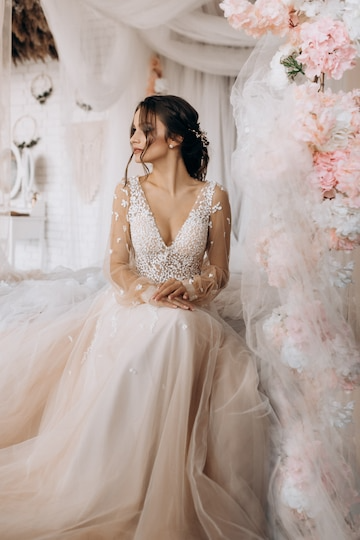Understanding the Materials Behind Our Gowns
The allure of wedding dresses is not just about their intricate designs or flattering silhouettes. It’s equally about the fabrics that drape, flow, and contour to accentuate a bride’s form. While the world of bridal fashion often dazzles with its vast array of styles, the unsung heroes behind these masterpieces are the materials that bring them to life. Today, let’s delve deep into the fabric of the matter, exploring the textile wonders that define the essence of wedding dresses, especially at establishments as prestigious as Two Birds Bridal.
The Ethereal Tulle
Walk into any bridal showroom, and it’s hard to miss the ubiquitous presence of tulle. Characterized by its lightweight, net-like structure, tulle has become synonymous with ballgowns and princess-inspired wedding dresses. Its ethereal quality allows for layering, adding volume without the weight. Whether it’s for a cascading veil or a voluminous skirt, tulle’s versatility is a designer’s delight.
The Timeless Satin
There’s a classic elegance about satin that’s hard to replicate. Known for its smooth finish and lustrous sheen, satin drapes beautifully, making it a preferred choice for structured gowns. While it’s often mistaken for being a type of fabric, satin refers to the weave. The material, whether silk, polyester, or acetate, gives it a rich, glossy surface, perfect for brides seeking a touch of old-world charm.
The Delicate Lace
Lace, with its intricate patterns and open weave, brings a vintage charm to wedding dresses. From the classic Alençon and Chantilly to the modern laser-cut versions, lace can be both demure and daring. It’s not uncommon to see lace appliqués adorning the bodice, sleeves, or the entire overlay of a gown, adding depth and texture to the ensemble.
The Sensuous Silk
Regarded as one of the most luxurious materials, silk has been a favorite in the bridal world for centuries. The natural protein fibers provide a smooth texture, and the fabric’s natural sheen radiates elegance. Varieties like silk charmeuse and silk dupioni offer different textures and finishes, allowing designers to craft gowns that range from slinky and sensuous to structured and sophisticated.
The Airy Chiffon
For brides dreaming of a beach wedding or a free-spirited bohemian affair, chiffon is the go-to fabric. This lightweight, sheer material flows gracefully, making it ideal for breezy wedding dresses. Often layered to create depth, chiffon gowns are known for their effortless movement and romantic appeal.
The Textured Organza
Somewhere between the stiffness of satin and the lightness of chiffon lies organza. This slightly sheer fabric is known for its stiffness, making it ideal for structured skirts and overlays. When embellished with embroidery or beadwork, organza wedding dresses shimmer with a subtle luminosity.
Choosing the Right Fabric
Understanding fabrics is pivotal for brides-to-be as they embark on their journey to find the perfect gown. Different materials suit different body types, venues, and seasons. For instance, while a heavy satin gown might be perfect for a winter wedding in a grand ballroom, it might not be the best choice for a summer beach ceremony.
When visiting showrooms like TwoBirds Bridal, it’s essential to touch and feel the fabrics, understanding how they drape and flow. The right material can elevate the design, ensuring the wedding dress isn’t just visually stunning but also comfortable.
Conclusion
The world of wedding dresses is as much about aesthetics as it is about the tactile experience. The choice of fabric plays a crucial role in determining the gown’s look, feel, and comfort. As brides-to-be explore their options, understanding the materials behind the masterpieces can guide them towards a gown that resonates with their vision and feels just right. After all, at the heart of every memorable wedding dress is a fabric story waiting to be told.
